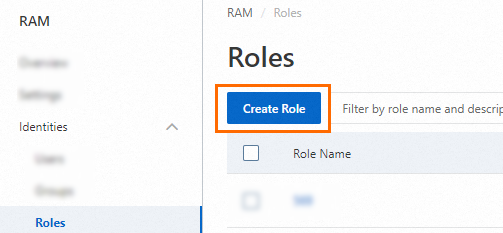This topic describes how to attach a policy to a Resource Access Management (RAM) role assumed by Container Registry to access custom Object Storage Service (OSS) buckets.
Background information
Default OSS bucket
Before you can use the default OSS bucket of Container Registry, you must grant Container Registry the permissions to access cloud resources. This way, Container Registry can create the default OSS bucket, and the Container Registry instance can be initialized.
Custom OSS bucket
If you want to use a custom OSS bucket, you must create a RAM role and grant the role the permissions on OSS buckets. Container Registry can access the custom OSS bucket after it assumes the RAM role.
Step 1: Create a RAM role
If you want Container Registry to access custom OSS buckets, you must create a role named AliyunContainerRegistryCustomizedOSSBucketRole for the Alibaba Cloud account to which your Container Registry instance belongs.
Procedure
Log on to the RAM console as a RAM user who has administrative rights.
In the left-side navigation pane, choose .
On the Roles page, click Create Role.

On the Create Role page, select Alibaba Cloud Account in the Select Role Type section and click Next.

Configure parameters for the RAM role.
Specify RAM Role Name.
Specify Note.
Select Current Alibaba Cloud Account or Other Alibaba Cloud Account in the Select Trusted Alibaba Cloud Account section.
Current Alibaba Cloud Account: If you want a RAM user that belongs to your Alibaba Cloud account to assume the RAM role, select Current Alibaba Cloud Account.
Other Alibaba Cloud Account: If you want a RAM user that belongs to a different Alibaba Cloud account to assume the RAM role, select Other Alibaba Cloud Account and enter the ID of the Alibaba Cloud account. This option is provided to grant permissions on resources that belong to different Alibaba Cloud accounts. For more information, see Use a RAM role to grant permissions across Alibaba Cloud accounts.
You can view the ID of your Alibaba Cloud account on the Security Settings page.
ImportantIf you want a specific RAM user instead of all RAM users that belong to your Alibaba Cloud account to assume the RAM role, you can use one of the following methods:
Modify the trust policy of the RAM role. For more information, see Example 1: Change the trusted entity of a RAM role to an Alibaba Cloud account.
Modify the role-assuming policy that is attached to the RAM user. For more information, see Can I specify the RAM role that a RAM user can assume?
Click OK.
Click Close.
Step 2: Attach a policy to the RAM role
Attach the AliyunContainerRegistryCustomizedOSSBucketRolePolicy policy to the RAM role. This policy contains the permissions to read information about Container Registry repositories from OSS buckets. To read repository information from multiple custom OSS buckets, you can specify multiple OSS buckets for the Resource parameter.
{
"Version": "1",
"Statement": [
{
"Action": [
"oss:GetObject",
"oss:PutObject",
"oss:DeleteObject",
"oss:ListParts",
"oss:AbortMultipartUpload",
"oss:InitiateMultipartUpload",
"oss:CompleteMultipartUpload",
"oss:DeleteMultipleObjects",
"oss:ListMultipartUploads",
"oss:ListObjects",
"oss:DeleteObjectVersion",
"oss:GetObjectVersion",
"oss:ListObjectVersions",
"oss:PutObjectTagging",
"oss:GetObjectTagging",
"oss:DeleteObjectTagging"
],
"Resource": [
"acs:oss:*:*:cri-*",
"acs:oss:*:*:cri-*/*",
"acs:oss:*:*:<YOUR_BUCKET_NAME>", # Replace <YOUR_BUCKET_NAME> with the name of the bucket that you want to access.
"acs:oss:*:*:<YOUR_BUCKET_NAME>/*" # Replace <YOUR_BUCKET_NAME> with the name of the bucket that you want to access.
],
"Effect": "Allow",
"Condition": {
}
},
{
"Action": [
"oss:PutBucket",
"oss:GetBucket",
"oss:GetBucketLocation",
"oss:PutBucketEncryption",
"oss:GetBucketEncryption",
"oss:PutBucketAcl",
"oss:GetBucketAcl",
"oss:PutBucketLogging",
"oss:GetBucketReferer",
"oss:PutBucketReferer",
"oss:GetBucketLogging",
"oss:PutBucketVersioning",
"oss:GetBucketVersioning",
"oss:GetBucketLifecycle",
"oss:PutBucketLifecycle",
"oss:DeleteBucketLifecycle",
"oss:GetBucketTransferAcceleration"
],
"Resource": [
"acs:oss:*:*:cri-*",
"acs:oss:*:*:cri-*/*",
"acs:oss:*:*:<YOUR_BUCKET_NAME>", # Replace <YOUR_BUCKET_NAME> with the name of the bucket that you want to access.
"acs:oss:*:*:<YOUR_BUCKET_NAME>/*" # Replace <YOUR_BUCKET_NAME> with the name of the bucket that you want to access.
],
"Effect": "Allow",
"Condition": {
}
},
{
"Effect": "Allow",
"Action": "oss:ListBuckets",
"Resource": [
"acs:oss:*:*:*",
"acs:oss:*:*:*/*"
],
"Condition": {
}
},
{
"Action": [
"vpc:DescribeVpcs"
],
"Resource": "acs:vpc:*:*:vpc/*",
"Effect": "Allow",
"Condition": {
}
},
{
"Action": [
"cms:QueryMetricLast",
"cms:QueryMetricList"
],
"Resource": "*",
"Effect": "Allow"
}
]
}
Step 3: Attach a trust policy to the RAM role
Add Container Registry to the trust policy of the RAM role. This way, Container Registry can access the custom OSS buckets.
{
"Statement": [
{
"Action": "sts:AssumeRole",
"Effect": "Allow",
"Principal": {
"Service": [
"cr.aliyuncs.com"
]
}
}
],
"Version": "1"
}